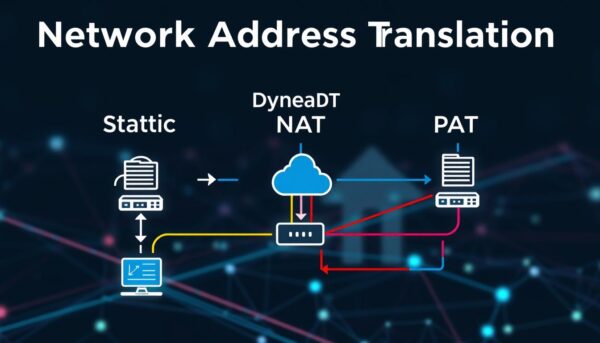✅ Last checked on
Ever wondered how millions of devices connect to the internet with just a few IP addresses? Network Address Translation (NAT) is the key. It’s a vital technology that has changed how we network today. Let’s explore NAT and see why it’s so important.
NAT is a hero of the internet. It lets many devices on a network use one public IP address. This smart move has helped save the limited number of IPv4 addresses. The Internet Assigned Numbers Authority (IANA) manages IP addresses, making NAT a key part of NAT networking basics.
Did you know there are only about 4 billion possible IPv4 addresses? That was enough in the 1970s. But today, with so many devices online, we’re running out. Think about all the devices you own that go online – phones, laptops, tablets, smart TVs. They all need IP addresses.
NAT acts as a traffic cop for your network. It helps data flow between your private network and the public internet. This way, your devices can talk to the outside world using just one public IP address. NAT has helped us use IPv4 longer, giving us time to switch to IPv6.
Knowing about NAT helps us understand how networks work today. It’s not just about saving IP addresses. NAT also helps keep networks safe and lets IPv4 and IPv6 work together. As we connect more devices and explore the internet, NAT stays crucial for our networks.
Key Takeaways
- NAT allows multiple devices to share a single public IP address
- It’s crucial for conserving the limited IPv4 address space
- NAT is managed by the Internet Assigned Numbers Authority (IANA)
- It bridges the gap between private and public networks
- NAT facilitates the transition from IPv4 to IPv6
- Understanding NAT is essential for grasping modern network operations
Understanding NAT Networking Basics
Network Address Translation (NAT) is a key technology in modern networking. It lets many devices on a private network share one public IP address. This is key for using IP addresses efficiently.
What is Network Address Translation?
NAT is a method that maps private IP addresses to a public one. It acts as a translator between your home network and the internet. When you browse the web, NAT changes your device’s private address to a public one, making internet communication possible.
How NAT Functions in Networks
NAT works by keeping a table of private and public IP addresses. When you send a request, NAT records your private IP and assigns a public IP. It then forwards your request using this public address. When the response comes back, NAT uses its table to send it to the right device on your network.

The Role of Private and Public IP Addresses
Private IP addresses are used within your local network. They’re not unique and can be reused in different networks. Public IP addresses are unique and used on the internet. NAT bridges these two worlds, allowing your devices to access the internet while maintaining network security.
| Private IP Range | Number of Addresses | Common Use |
|---|---|---|
| 10.0.0.0 – 10.255.255.255 | 16,777,216 | Large enterprise networks |
| 172.16.0.0 – 172.31.255.255 | 1,048,576 | Medium-sized networks |
| 192.168.0.0 – 192.168.255.255 | 65,536 | Home networks, small offices |
NAT Firewalls add an extra layer of security by hiding your internal network structure from the outside world. They act as a barrier, allowing only authorized traffic to pass through, enhancing your network’s protection against potential threats.
Types of Network Address Translation
Network Address Translation (NAT) has three main types, each for different needs. Knowing these helps you pick the best for your network.
Static NAT Implementation
Static NAT maps private and public IP addresses one-to-one. It’s great for hosting services like web or email servers. This ensures constant internet access, perfect for Port Forwarding.
Dynamic NAT Solutions
Dynamic NAT lets you use a pool of public IP addresses. It’s perfect for networks with a set number of users. This method supports many-to-many mapping, making it efficient for internet access.
Port Address Translation (PAT)
PAT, or NAT overload, is the most common. It lets many private IP addresses share one public IP. PAT uses Port Mapping to identify devices, making it efficient for small networks.

| NAT Type | Mapping | Best Use Case |
|---|---|---|
| Static NAT | One-to-One | Web Hosting |
| Dynamic NAT | Many-to-Many | Office Networks |
| PAT | Many-to-One | Home Networks |
Each NAT type has its own benefits. Static NAT ensures constant access, Dynamic NAT is flexible, and PAT saves IP addresses. Your choice depends on your network’s needs and size.
Benefits and Implementation of NAT
NAT networking basics bring big advantages for managing and securing your network. It helps save public IP addresses, which are limited. With only about 4 billion unique IPv4 addresses worldwide, this is key.
NAT also hides your network’s internal structure. This boosts privacy and makes it tougher for hackers to find your network. Over 80% of organizations using NAT say it has improved their security and privacy.
NAT makes network management easier by reducing the need for address changes. This is great for dynamic environments where network needs change often. For example, dynamic NAT lets organizations give public IPs to devices as needed, saving resources.
Understanding NAT techniques is important for effective implementation. Port Address Translation (PAT) lets hundreds of devices share one public IP. Each device gets a unique port number for communication. This means an office with 100 employees can use just one public IP while keeping their communications separate.
For peer-to-peer apps, STUN protocols are vital for NAT traversal. They help devices behind NAT talk to each other in star topology networks. This ensures smooth operation of internet services.
While NAT has many benefits, it’s not without drawbacks. It can cause slight delays in packet processing, adding about 10% to latency. But, the benefits in saving IP addresses and enhancing security usually outweigh this minor drawback.
NAT’s Role in Network Security and IPv6 Transition
NAT is key in network security and the move to IPv6. It helps with both, making networks safer and smoother.
Security Advantages and Limitations
NAT Firewalls hide your network’s IP addresses from the internet. This IP Address Translation makes it tough for hackers to find your devices. Studies show a 50-70% drop in visible network structure, boosting security.
But, NAT isn’t enough on its own. You need other security steps to fully protect your network.
NAT in IPv6 Migration
As we switch from IPv4 to IPv6, NAT is a bridge. IPv4 addresses are almost gone, with only 4.3 billion left. NAT lets many devices use one public IP, helping IPv4 last longer while we move to IPv6.
NAT64 and NAT46 Solutions
NAT64 and NAT46 help IPv4 and IPv6 networks talk to each other. They’re key for a smooth transition. They let IPv4 devices use IPv6 services and vice versa.
| NAT Type | Function | Use Case |
|---|---|---|
| NAT64 | Translates IPv6 to IPv4 | Allows IPv6-only clients to access IPv4 servers |
| NAT46 | Translates IPv4 to IPv6 | Enables IPv4-only clients to reach IPv6 services |
Knowing how NAT works in security and IPv6 helps you plan better. It ensures your network evolves smoothly.
Conclusion
Network Address Translation (NAT) is key in today’s networking. It helps manage the limited IPv4 address space. With over 30 billion devices expected by 2025, NAT’s role in saving IP addresses is vital.
You’ve seen different NAT types, each with its own use. Static NAT is for servers, while dynamic NAT works for many devices. Port Address Translation (PAT) lets thousands share one public IP, perfect for homes and small businesses.
NAT does more than save IP addresses. It also boosts network security by hiding internal IP addresses. This reduces attack risks. For companies, NAT can save a lot of money by cutting down on public IP needs.
But, NAT has downsides like performance issues and problems with peer-to-peer connections.
NAT is evolving with the network. It mainly deals with IPv4, but NAT64 and NAT46 help with IPv6. Knowing about NAT is essential for managing and fixing networks in our connected world. It helps you understand the complex world of modern networking.